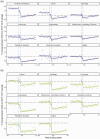Impact of COVID-19 on accident and emergency attendances and emergency and planned hospital admissions in Scotland: an interrupted time-series analysis
- PMID: 33012218
- PMCID: PMC7686524
- DOI: 10.1177/0141076820962447
Impact of COVID-19 on accident and emergency attendances and emergency and planned hospital admissions in Scotland: an interrupted time-series analysis
Abstract
Objectives: Following the outbreak of the severe acute respiratory syndrome coronavirus 2 (SARS-CoV-2) virus and the subsequent global spread of the 2019 novel coronavirus disease (COVID-19), health systems and the populations who use them have faced unprecedented challenges. We aimed to measure the impact of COVID-19 on the uptake of hospital-based care at a national level.
Design: The study period (weeks ending 5 January to 28 June 2020) encompassed the pandemic announcement by the World Health Organization and the initiation of the UK lockdown. We undertook an interrupted time-series analysis to evaluate the impact of these events on hospital services at a national level and across demographics, clinical specialties and National Health Service Health Boards.
Setting: Scotland, UK.
Participants: Patients receiving hospital care from National Health Service Scotland.
Main outcome measures: Accident and emergency (A&E) attendances, and emergency and planned hospital admissions measured using the relative change of weekly counts in 2020 to the averaged counts for equivalent weeks in 2018 and 2019.
Results: Before the pandemic announcement, the uptake of hospital care was largely consistent with historical levels. This was followed by sharp drops in all outcomes until UK lockdown, where activity began to steadily increase. This time-period saw an average reduction of -40.7% (95% confidence interval [CI]: -47.7 to -33.7) in A&E attendances, -25.8% (95% CI: -31.1 to -20.4) in emergency hospital admissions and -60.9% (95% CI: -66.1 to -55.7) in planned hospital admissions, in comparison to the 2018-2019 averages. All subgroup trends were broadly consistent within outcomes, but with notable variations across age groups, specialties and geography.
Conclusions: COVID-19 has had a profoundly disruptive impact on hospital-based care across National Health Service Scotland. This has likely led to an adverse effect on non-COVID-19-related illnesses, increasing the possibility of potentially avoidable morbidity and mortality. Further research is required to elucidate these impacts.
Keywords: A&E attendances; COVID-19; SARS-CoV-2; hospital admissions; secondary care; uptake.
Conflict of interest statement
Figures





Comment in
-
COVID-19: state failure is our misery and their jackpot.J R Soc Med. 2020 Nov;113(11):419-420. doi: 10.1177/0141076820972325. J R Soc Med. 2020. PMID: 33167765 Free PMC article. No abstract available.
-
Health inequalities worsen with the drop in hospital referrals.J R Soc Med. 2021 Apr;114(4):158-159. doi: 10.1177/0141076820982285. Epub 2021 Feb 11. J R Soc Med. 2021. PMID: 33571025 Free PMC article. No abstract available.
References
-
- Kelly E and Firth Z. The Health Foundation. How Is COVID-19 Changing the Use of Emergency Care? 15 May 2020. See https://www.health.org.uk/news-and-comment/charts-and-infographics/how-i... (last checked 30 June 2020).
-
- NHS England. A&E Attendances and Emergency Admissions. March 2020 Statistical Commentary. See https://www.england.nhs.uk/statistics/wp-content/uploads/sites/2/2020/04... (last checked 10 July 2020).
-
- Patriti A, Baiocchi GL, Catena F, Marini P, Catarci M. FACS on behalf of the Associazione Chirurghi Ospedalieri Italiani (ACOI). Emergency general surgery in Italy during the COVID-19 outbreak: first survey from the real life. World J Emerg Surg 2020; 15: article number 36–article number 36. - PMC - PubMed
MeSH terms
Grants and funding
LinkOut - more resources
Full Text Sources
Medical
Miscellaneous

